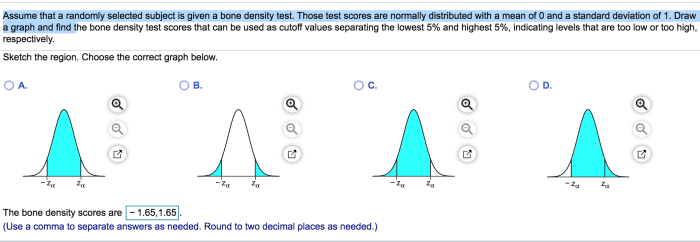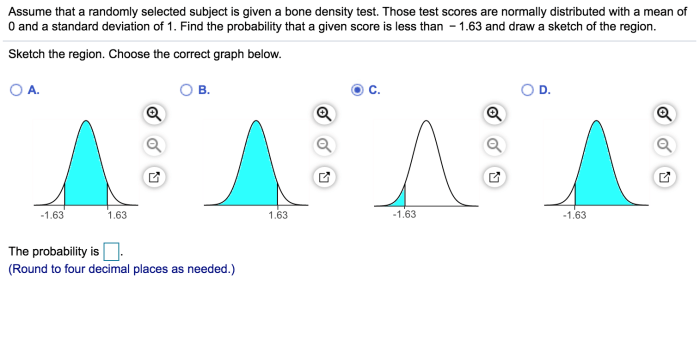Assume that a randomly selected subject is given a bone. What does this imply? This seemingly straightforward assumption opens up a world of scientific inquiry and ethical considerations. Join us as we delve into the implications and applications of this concept, exploring the physical properties of bones, techniques for their analysis, and the ethical considerations surrounding the study of human remains.
Bones, the rigid structures that support our bodies, hold a wealth of information about our health, diet, and lifestyle. By examining their physical characteristics, composition, and microscopic details, scientists can gain insights into an individual’s past and present. This knowledge has proven invaluable in fields ranging from forensic investigations to archaeological research.
Assumptions and Considerations

The assumption that a randomly selected subject is given a bone implies that the subject has been provided with a bone specimen for examination and analysis. This assumption has several implications and limitations:
Implications:
- The subject is expected to have basic knowledge and understanding of bone anatomy and properties.
- The bone specimen is assumed to be intact and representative of a specific individual.
- The assumption allows for the application of standardized examination and analysis techniques.
Limitations:
- The assumption may not be valid in situations where the subject lacks the necessary knowledge or skills to handle and examine bones.
- The bone specimen may not always be complete or representative, which could affect the accuracy of analysis.
- The assumption does not account for variations in bone characteristics and properties due to factors such as age, sex, and health status.
Examples of situations where this assumption may or may not be valid:
- Valid:A forensic anthropologist examining a bone specimen from a crime scene.
- Not valid:A student with no prior experience in osteology attempting to identify a bone.
Bone Characteristics and Properties
Bones are hard, mineralized tissues that form the skeletal system of vertebrates. They provide support, protection, and movement, and serve as reservoirs for minerals and hematopoietic tissue.
Physical Characteristics
- Hardness:Bones are one of the hardest tissues in the body, due to their high mineral content.
- Strength:Bones are strong and can withstand significant forces, both compressive and tensile.
- Flexibility:Bones are flexible enough to withstand bending and twisting without breaking.
- Lightweight:Bones are lightweight, despite their strength and hardness, due to their porous structure.
Types of Bones
There are several types of bones in the body, each with its own unique shape and function:
- Long bones:Long, cylindrical bones found in the limbs, such as the femur and humerus.
- Short bones:Short, cube-shaped bones found in the wrist and ankle, such as the carpals and tarsals.
- Flat bones:Thin, flat bones that form the skull and rib cage, such as the parietal bone and the sternum.
- Irregular bones:Bones with complex shapes that do not fit into the other categories, such as the vertebrae and the mandible.
Composition and Structure
Bones are composed of a mineral matrix and a collagenous matrix:
- Mineral matrix:Consists of calcium phosphate crystals, which provide hardness and strength.
- Collagenous matrix:Consists of collagen fibers, which provide flexibility and toughness.
The combination of these two matrices gives bones their unique combination of properties.
Bone Handling and Examination

Proper handling and examination of bones are essential to ensure accurate analysis and interpretation.
Handling
- Wear gloves:To protect the bones from contamination and to prevent the transfer of skin cells.
- Use clean instruments:To avoid introducing contaminants or damaging the bones.
- Handle bones gently:To avoid breaking or damaging them.
Examination
- Visual examination:Observe the bone’s shape, size, and surface features.
- Palpation:Feel the bone’s surface for any irregularities or defects.
- Percussion:Tap the bone gently to assess its density and hardness.
- Auscultation:Listen for any sounds produced by tapping the bone.
Identification and Classification
Bones can be identified and classified based on their anatomical location, shape, and size:
- Anatomical location:The location of the bone in the body, such as the skull, limb, or spine.
- Shape:The overall shape of the bone, such as long, short, flat, or irregular.
- Size:The length, width, and thickness of the bone.
Documentation and Preservation, Assume that a randomly selected subject is given a bone
It is important to document and preserve bone specimens for future reference and analysis:
- Documentation:Record all relevant information about the bone, such as its anatomical location, condition, and any observations made during examination.
- Preservation:Store the bone in a dry, cool environment to prevent decay.
Bone Analysis and Interpretation
Bones can be analyzed using a variety of techniques to provide insights into an individual’s health, diet, and lifestyle.
Microscopy
- Light microscopy:Used to examine the bone’s microstructure and identify cellular components.
- Electron microscopy:Used to examine the bone’s ultrastructure and identify specific proteins and minerals.
Imaging
- X-ray:Used to visualize the bone’s internal structure and identify any fractures or abnormalities.
- CT scan:Used to create detailed cross-sectional images of the bone.
- MRI:Used to visualize the bone’s soft tissues and identify any pathological changes.
Chemical Analysis
- Stable isotope analysis:Used to determine the individual’s diet and geographic origin.
- DNA analysis:Used to identify the individual and determine their genetic ancestry.
Interpretation
Bone analysis can provide valuable insights into an individual’s:
- Health:Identify diseases and conditions that affect bone health, such as osteoporosis and arthritis.
- Diet:Determine the individual’s dietary habits, such as protein intake and vitamin deficiencies.
- Lifestyle:Identify activities that may have impacted bone health, such as physical activity and smoking.
Examples of Bone Analysis in Research and Forensics
- Archaeological research:Used to study the health and lifestyle of ancient populations.
- Forensic investigations:Used to identify victims of crime and determine the cause of death.
Ethical Considerations: Assume That A Randomly Selected Subject Is Given A Bone

The study and analysis of human remains raise important ethical considerations.
Informed Consent and Privacy
- Informed consent:Obtain informed consent from individuals or their families before using their remains for research or analysis.
- Privacy:Respect the privacy of individuals and ensure that their remains are handled with dignity and confidentiality.
Legal and Regulatory Frameworks
There are legal and regulatory frameworks governing bone research and analysis:
- Institutional review boards (IRBs):Review and approve research involving human remains to ensure ethical conduct.
- National laws and regulations:Vary by country and govern the collection, storage, and use of human remains for research and analysis.
Query Resolution
What are the limitations of assuming that a randomly selected subject is given a bone?
This assumption may not be valid in cases where the subject has a rare bone condition or has undergone bone surgery.
What are the different types of bones?
There are five main types of bones: long bones, short bones, flat bones, irregular bones, and sesamoid bones.
What is the importance of documenting and preserving bone specimens?
Proper documentation and preservation ensure that bone specimens can be used for future research and analysis.